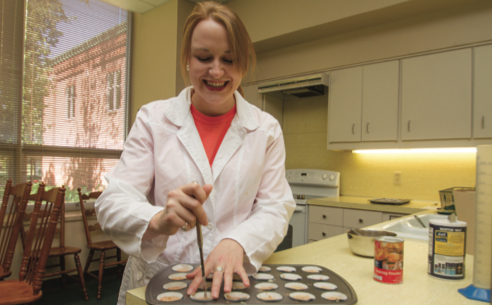Family and consumer sciences students utilize the food science lab in the Olen Hendrix Building to take cooking to a new level. This food lab hosts multiple, fully equipped kitchens in which students learn the chemistry of recipes and test baking variations using the scientific method.
Senior nutrition and dietetics major Joanna Nelson has used the food science lab for multiple classes.
“Our class uses it for advanced food science class, which is our senior level research class,” Nelson said. “We’re manipulating recipes, and we’ll gather data and write a paper and have a test panel.”
The actual lab is also used for freshman-level courses and for family resource management class, in which students plan and budget meals and invite guests to try them.
“Say you wanted to reduce the fat in a recipe, you would learn how to replace the fat in a recipe,” Nelson said. “You’re just changing a variable in the recipe and testing consumer acceptance of the change.”
The kitchens are not only equipped with whisks and measuring cups, but have become a mix of a kitchen and a chemistry lab with scales and graduated cylinders. Instead of measuring flour, lab users weigh flour so recipes are exact down to the gram. To the casual cook, this meticulous process may seem extreme, but according to Nelson, these processes are important for a number of consumers.
“Simple substitutions are sometimes necessary if you are out of an ingredient or if you have an allergy or intolerance and you need to apply that to your diet or for whoever you’re cooking for,” Nelson said. “(Food science) does apply to everyone, you just might not know it or might not be utilizing it.”
Learning to make substitutions in original recipes has provided nutritious alternatives for people with food allergies like gluten, wheat or dairy allergies. If a recipe calls for two eggs and there is only one in the fridge, there are alternatives that will create an equally tasty dish, which can come in handy for poor college students.
